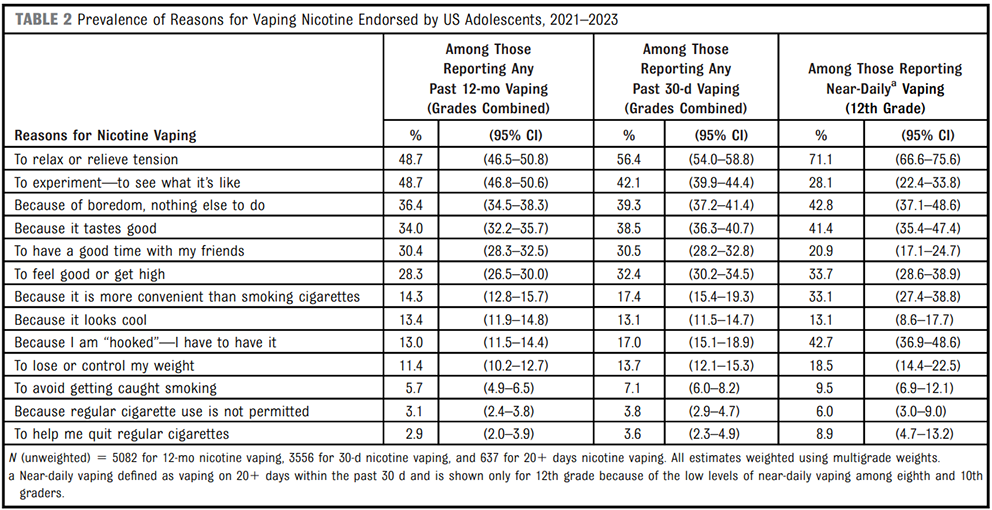
Vaping Among Adolescents in the United States
Background
A recent study illustrated the frequency and reasons for vaping nicotine among adolescents in the United States. Nicotine vaping is prevalent among adolescents in the United States and is gaining popularity as a less harmful alternative to cigarette smoking. However, this is a critical public health concern as there are serious results from nicotine vaping such as dependence risk, and respiratory, neurologic, and cardiovascular problems2.
This study received institutional review board approval from the University of Michigan and was supported by research grants from the National Institute on Drug Abuse and National Institute of Health.
Study Method
The study, Monitoring the Future, was conducted using in-school web surveys from 2021 to 2023. Questions were randomly asked of 28,522 students and the average response rate was 79%. The questions focused on frequency of vaping and reasons for vaping among eighth, 10th, and 12th grade students.
Results
The prevalence of nicotine vaping increased comparing data from the 8th grade up to the 12th grade for all three time segments: Any past 12-mo, Any past 30-day, and Near-daily.
 There was a wide range of reasons given for nicotine vaping. Survey respondents could select as many reasons for vaping from a list of 13 reasons. The most common reasons for each time segment are listed below:
There was a wide range of reasons given for nicotine vaping. Survey respondents could select as many reasons for vaping from a list of 13 reasons. The most common reasons for each time segment are listed below:
| Reason | Any Past 12-month | Any Past 30-day | Near-Daily |
| Relax/relieve tension | 48.70% | 56.40% | 71.10% |
| To experiment | 48.70% | 42.10% | * |
| Boredom | 36.40% | 39.30% | 42.80% |
| Tastes Good | 34.00% | 38.50% | 41.40% |
*The Near-Daily group responded 28.1% for “to experiment.”
All reasons are listed below:

Discussion
A wide range of reasons for nicotine vaping were provided by US adolescents; however, the top reason was to relax or relieve tension. Screening for nicotine vaping alongside stress and anxiety may be an important tool for early intervention efforts because using to relax is associated with increased risk of future dependence. The authors suggest that additional research is needed to determine what tools are most effective for the various reasons cited by US adolescents.
DTPM Solutions
DTPM’s mission is to help laboratories by providing testing solutions that meet the need. DTPM offers cotinine (nicotine) reagents for testing in your laboratory or, we offer cotinine testing via LC-MS on samples sent to our laboratory. General testing supplies such as gloves, lint-free wipes, and pipet tips are also available on our online store.
Contact us today to learn how DTPM can help your laboratory achieve successful and efficient operations.
- Patrick ME, Terry-McElrath YM, Arterberry B, et al. Reasons for Vaping Among US Adolescents. Pediatrics. 2024;154(6):e2024067856
- Hamann SL, Kungskulniti N, Charoenca N, Kasemsup V, Ruangkanchanasetr S, Jongkhajornpong P. Electronic cigarette harms: aggregate evidence shows damage to biological systems. Int J Environ Res Public Health. 2023;20(19):6808
